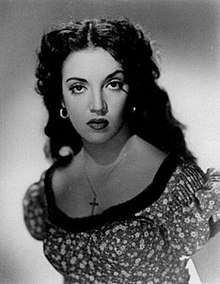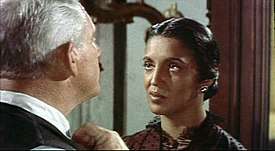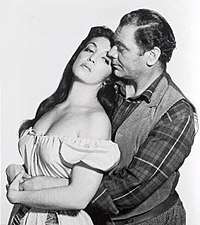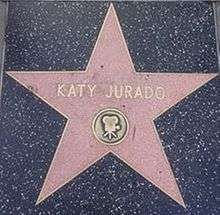Katy Jurado
| Katy Jurado | |
|---|---|
 Jurado in 1953 | |
| Born |
María Cristina Estela Marcela Jurado García 16 January 1924 Guadalajara, Jalisco, Mexico |
| Died |
5 July 2002 (aged 78) Cuernavaca, Morelos, Mexico |
| Resting place | Panteon de La Paz, Cuernavaca |
| Occupation | Actress |
| Years active | 1943–2002 |
| Spouse(s) |
Víctor Velázquez (m. 1939; div. 1943) |
| Children | 2 |
| Signature | |
 | |
María Cristina Estela Marcela Jurado García (16 January 1924 – 5 July 2002), better known as Katy Jurado, was a Mexican film, stage, and television actress.
Jurado began her acting career in Mexico in 1943. From the 1940s through the early 1960s, the era called the Golden Age of Mexican cinema, Jurado played villainous "femme fatale" characters in Mexican films. In 1951 she was discovered in Mexico by the filmmaker Budd Boetticher and began her Hollywood career in the film The Bullfighter and the Lady. She acted in Western films of the 1950s and 1960s, including High Noon (1952), Arrowhead (1953), Broken Lance (1954), One-Eyed Jacks (1961), and Pat Garrett and Billy the Kid (1973). She was the first Latin American actress nominated for an Academy Award, as Best Supporting Actress for her work in Broken Lance, and was the first to win a Golden Globe Award for her performance in High Noon.
Life and career
Childhood and film debut (1924–1943)
Katy Jurado was born María Cristina Jurado García in Guadalajara, Jalisco, Mexico on 16 January 1924.[1] Her parents were Luis Jurado Ochoa and Vicenta Estela García de la Garza. Her brothers were Luis Raúl and Óscar Sergio. Her father was a lawyer, and her mother was a singer who worked for XEW.[1] Her mother was sister of Mexican musician Belisario de Jesús García, author of popular Mexican songs like "Las Cuatro Milpas". Jurado's cousin Emilio Portes Gil was president of Mexico (1928–1930).[2]
Jurado studied at a school run by nuns in the Guadalupe Inn neighborhood in Mexico City, and later studied to be a bilingual secretary. As a teenager, she was invited by producers and filmmakers to work as an actress, among them Mexican filmmaker Emilio Fernández, who offered her a role in his first movie The Isle of Passion (1941). Although her godfather was Mexican actor Pedro Armendáriz, her parents never gave their consent.[3]
Another filmmaker interested in her was Mauricio de la Serna, who offered Jurado a role in the film No matarás (1943).[1] She signed the contract without authorization from her parents, and when they found out, they threatened to send her to a boarding school in Monterrey. Around this time she met the aspiring actor Victor Velázquez and married him shortly after. Velázquez and Jurado were married until 1946.[4]
In No matarás, Jurado played her first villain and femme fatale.[5] Jurado specialized in playing wicked and seductive women.[6] Jurado said:
| “ | "Sabía que mi cuerpo era provocativo, pero también que no era bella, aunque sí, reconozco, mi tipo era distinto y muy sensual" (Spanish for, "I knew that my body was provocative. I admit, my physique was different and very sensual.")[1] | ” |
She appeared in sixteen more films over the next seven years in what film historians have named the Golden Age of Mexican cinema. In 1943 she had her first success with her third film, La vida inútil de Pito Pérez.
Success in Hollywood (1951–1968)
In addition to acting, Jurado worked as a movie columnist, radio reporter and bullfight critic to support her family.[7] She was on assignment when filmmaker Budd Boetticher and actor John Wayne spotted her at a bullfight. Neither knew she was an actress. However, Boetticher, who was also a professional bullfighter, cast Jurado in his 1951 film Bullfighter and the Lady, opposite Gilbert Roland, as the wife of an aging matador. She had rudimentary English language skills, and memorized and delivered her lines phonetically. Despite this handicap, her strong performance brought her to the attention of Hollywood producer Stanley Kramer, who cast her in the classic Western High Noon, starring Gary Cooper and Grace Kelly. Jurado learned to speak English for the role, studying and taking classes two hours a day for two months. She played saloon owner Helen Ramírez, former love of reluctant hero Cooper's Will Kane. She earned a Golden Globe Award for Best Supporting Actress and gained notice in the American movie industry.[8]

Despite her Hollywood success in the early 1950s, Jurado continued to act in Mexican productions. In 1953 she starred in Luis Buñuel's box-office success El Bruto, with Pedro Armendáriz, for which she received a Silver Ariel Award (The Mexican Academy Award) as Best Supporting Actress. She also acted in English-language films produced in Mexico, such as El Corazón y La Espada (1953, opposite Cesar Romero) and Mujeres del Paraíso (1954, opposite Dan O'Herlihy). The same year she had a role in Arrowhead with Charlton Heston and Jack Palance, playing an evil Comanche woman, the love-interest of Heston's character.
In 1954, Mexican actress Dolores del Río was chosen to play Spencer Tracy's Comanche wife and the mother of Robert Wagner's character in the film Broken Lance, directed by Edward Dmytryk. However, del Río was accused of being a communist during the McCarthy era.[8] Jurado was then chosen for the role despite the resistance of the studio because of her youth. But after viewing footage of her scenes, studio executives were impressed.[9] Her performance garnered an Academy Award nomination (a distinction shared by only two other Mexican actresses since then: Salma Hayek as Best Actress in 2002 for Frida, and Adriana Barraza as Best Supporting Actress in 2006 for Babel).

In 1954, Jurado appeared with Kirk Douglas and Cesar Romero in the Henry Hathaway's film The Racers, filmed in France, Italy and Spain. In 1955, Jurado filmed Trial, directed by Mark Robson, with Glenn Ford and Arthur Kennedy. It was a drama about a Mexican boy accused of raping a white girl, with Jurado playing the mother of the accused. For this role she was again nominated for the Golden Globe Award for Best Supporting Actress.[10] In the same year she traveled to Italy for the filming of Trapeze, directed by Carol Reed, with Burt Lancaster and Tony Curtis.
In 1956, Jurado debuted on Broadway, playing Filomena Marturano with Raf Vallone. Eventually she participated in a series of westerns like Man from Del Rio, opposite the Mexican actor Anthony Quinn, and Dragoon Wells Massacre with Barry Sullivan. She made guest television appearances in a 1957 episode of Playhouse Drama and in a 1959 episode of The Rifleman as gambler Julia Massini (Andueza) in "The Boarding House", written and directed by Sam Peckinpah.
In 1959, she filmed The Badlanders, with Ernest Borgnine and Alan Ladd, and worked with Marlon Brando in the film One-Eyed Jacks. In the film, Jurado played the role of Karl Malden's wife, and mother of the young Mexican actress Pina Pellicer.
In 1961, she starred in Dino de Laurentiis Italian productions like Barabbas with Ernest Borgnine, Anthony Quinn, Jack Palance, and the Italian actors Silvana Mangano and Vittorio Gassman, and I braganti Italiani, directed by Mario Camerini, again with Borgnine and Gassman. In 1961, Jurado returned to Mexico. She filmed Y dios la llamó Tierra (1961) and La Bandida (1963), with the Mexican cinema stars María Félix, Pedro Armendáriz and Emilio Fernández.
Jurado appeared as saloon owner Maria Gertrudis Barceló in the 1962 episode, "La Tules", of the syndicated anthology series, Death Valley Days, narrated by Stanley Andrews.
In 1965, Jurado returned to Hollywood in the film Smoky, directed by George Sherman, starring Fess Parker. In 1966, she played the mother of the character played by George Maharis in A Covenant with Death. As her career in the U.S. began to wind down, she appeared in the film, Stay Away, Joe (1968) in the role of the half-Apache stepmother of the character played by Elvis Presley.[8]
In 1968, she moved back to Mexico permanently and established residence in the city of Cuernavaca.
Later years (1970–2002)
In the next years Jurado alternated her work between Hollywood and Mexico. In 1970 she filmed the Hollywood film production The Bridge in the Jungle, opposite John Huston. In 1973 she appeared in Pat Garrett and Billy the Kid, directed by Sam Peckinpah, playing the role of the wife of the actor Slim Pickens.
Jurado received one of her best dramatic roles in the last episode of the Mexican film Fé, Esperanza y Caridad (1973). Directed by Jorge Fons, Jurado was cast as Eulogia ("La Camota"), a lower-class woman who suffers a series of bureaucratic abuses to claim the remains of her dead husband. For this role she won her second Silver Ariel Award of the Mexican Cinema. Jurado recognized this character as her best performance.[11] In 1973 Jurado starred on Broadway again in the Tennessee Williams stage play The Red Devil Battery Sign, with Anthony Quinn and Claire Bloom.
In 1974 Jurado appeared in the American film Once Upon a Scoundrel (1974), opposite the American comedian Zero Mostel. In 1975 she participated in the social criticism film Los albañiles, again directed by Jorge Fons. The film was awarded with the Golden Bear of the Berlinale 1975. In 1976 appears in the role of Chuchupe in the film Pantaleón y Las Visitadoras (1976) adaptation of the novel of Mario Vargas Llosa (who also directed the film). In 1978 she played a small role in the film The Children of Sanchez (1978), opposite Anthony Quinn and Dolores del Rio. Jurado also reappeared on television frequently in the 1970s.
In 1980 Jurado filmed La Seducción (1980), directed by Arturo Ripstein. In 1984, she acted in the film Under the Volcano, directed by John Huston. In the same year she co-starred in the short-lived television series a.k.a. Pablo, a situation comedy series for ABC, with Paul Rodriguez.
In the 1990s Jurado appeared in two Mexican Telenovelas. In 1992, she was honored with the Golden Boot Award for her notable contribution to the Western genre. In 1998, she completed a timely Spanish-language film for director Arturo Ripstein called El Evangelio de las Maravillas, about a millennium sect. She won the best supporting Actress Silver Ariel for this role.[8] Jurado had a cameo in the film The Hi-Lo Country by the filmmaker Stephen Frears, who called her his "lucky charm" for his first Western.[12]
In 2002 she made her final film appearance in Un secreto de Esperanza. The film was released posthumously.
Personal life
Jurado's first husband was the Mexican actor Victor Velázquez (the stepfather of the popular Mexican actresses Tere and Lorena Velázquez). With Velázquez she had two children, Víctor Hugo (d. 1981) and Sandra.
Early in her career in Hollywood, Jurado had affairs with the filmmaker Budd Boetticher, and actor Tyrone Power.[6][13]
Marlon Brando was smitten with Jurado after seeing her in High Noon.[6] They met when Brando was filming in Mexico Viva Zapata!. He was involved at the time with Movita Castaneda, and was having a parallel relationship with Rita Moreno. Brando told Joseph L. Mankiewicz that he was attracted to "her enigmatic eyes, black as hell, pointing at you like fiery arrows".[7] Jurado recalled years later in an interview that:
| “ | Marlon called me one night for a date, and I accepted. I knew all about Movita. I knew he had a thing for Rita Moreno. Hell, it was just a date. I didn't plan to marry him.[7] | ” |
However, their first date became the beginning of an extended affair that lasted many years and peaked at the time they worked together on One-Eyed Jacks (1960), a film directed by Brando.[7] Jurado commented:
| “ | He has been my close friend. I say that Marlon and I have been true friends of the soul, we speak soul to soul."[14] | ” |

During the filming of the movie Vera Cruz in México, Jurado met the American actor Ernest Borgnine, who became her second husband on December 31, 1959.[6] Jurado recalled: "Borgnine and I met by accident when we collided in a dark room when leaving a restaurant. He chased me for two years. What did I do for that this man loves me this way? Our courtship was one of the best periods of my life. We were married soon after, but his jealousy and insecurities turned the marriage into hell."[15] Jurado and Borgnine divorced in 1963.
Jurado had a romantic relationship with the western novelist Louis L'Amour. She said: "I have love letters that he wrote me until the last day of his life."[15]
She also maintained a relationship with John Wayne.[6]
Her son Victor Hugo died tragically in an accident on a highway near Monterrey in 1981, plunging her into a deep depression that she could never overcome, and that led her to abandon her acting career for a few years. While this happened, Jurado was filming a movie in Mexico. She commented:
| “ | When my son died I was filming a movie in Mexico. He took with him half of my life. I could not mourn him as I wanted. I went to the funeral and I had to return to film the movie. Every day when I saw the camera I hated her. I dedicated to the films a wonderful time I should have given to my children, but it was too late."[16] | ” |
Jurado said:
| “ | John Huston was to get me out of my house for Under the Volcano. I was very sad about the death of my son. I know very well that he offered me the film to give me strength and comfort."[17] | ” |
Jurado maintained close friendships with stars such as Burt Lancaster, Sam Peckinpah, Frank Sinatra, Alan Ladd and Sammy Davis Jr..
Jurado claimed to have been one of the first people to find the body of Mexican actress Miroslava Stern after her tragic suicide. According to Jurado, the picture that Miroslava had between her hands was of Cantinflas, but artistic manager Fanny Schatz exchanged the photo for one of the Spanish bullfighter Luis Miguel Dominguín.[18]
In 1998, the Mexican composer Juan Gabriel dedicated a song to Jurado called Que re'chula es Katy (What a beauty is Katy).[19]
Death and legacy

Towards the end of her life, Jurado suffered from heart and lung ailments. She died of kidney failure and pulmonary disease on 5 July 2002, at the age of 78, at her home in Cuernavaca, Morelos, Mexico.[20] She was buried in Cuernavaca at the Panteón de la Paz cemetery.
Jurado has a star on the Hollywood Walk of Fame at 7065 Hollywood Boulevard for her contributions to motion pictures.
She was honored with a Google Doodle on January 16, 2018.[21]
Filmography
Notes
- 1 2 3 4 Alberto, López (16 January 2018). "Katy Jurado, la bella mexicana de los papeles complicados en Hollywood". El País (in Spanish). Retrieved 12 May 2018.
- ↑ Arnáiz, Laura (1999). "Katy Jurado: Proudly Mexican Hollywood Star". SOMOS: 8.
- ↑ Muñoz Castillo, Fernando (1999). "Katy Jurado: Proudly Mexican Hollywood Star". SOMOS: 16.
- ↑ Arnáiz, Laura (1999). "Katy Jurado: Proudly Mexican Hollywood Star". SOMOS: 23–24.
- ↑ "No matarás (1943)". FilmAffinity (in Spanish). Retrieved 12 May 2018.
- 1 2 3 4 5 "Katy Jurado, la mujer fatal que tuvo a Marlon Brando y John Wayne a sus pies". El Periódico de Catalunya (in Spanish). 16 January 2018. Retrieved 12 May 2018.
- 1 2 3 4 Porter, Darwin. Brando Unzipped, p.394
- 1 2 3 4 Ruiz & Sánchez Korrol. Latinas in the United States, p.358
- ↑ Gonzalez Rubio, Javier; García Riera, Emilio (1999). El cine de Katy Juardo (The films of Katy Jurado). México: Universidad de Guadalajara (Centro de Investigaciones y Enseñanza Cinematográficas), Patronato de la Muestra de Cine Mexicano en Guadalajara, A. C. e Instituto Mexicano de Cinematografía (IMCINE). pp. 25–26. ISBN 968-895-854-9.
- ↑ Terán, Luis (1999). "Katy Jurado: Proudly Mexican Hollywood Star". SOMOS: 58–59.
- ↑ Gonzalez Rubio, Javier; García Riera, Emilio (1999). El cine de Katy Jurado (The films of Katy Jurado). México: Universidad de Guadalajara (Centro de Investigaciones y Enseñanza Cinematográficas), Patronato de la Muestra de Cine Mexicano en Guadalajara, A. C. e Instituto Mexicano de Cinematografía (IMCINE). pp. 32, 33. ISBN 968-895-854-9.
- ↑ Gonzalez Rubio, Javier; García Riera, Emilio (1999). El cine de Katy Jurado (The films of Katy Jurado). Universidad de Guadalajara (Centro de Investigaciones y Enseñanza Cinematográficas), Patronato de la Muestra de Cine Mexicano en Guadalajara, A. C. e Instituto Mexicano de Cinematografía (IMCINE). p. 33. ISBN 968-895-854-9.
- ↑ Arnáiz, Laura (1999). "Katy Jurado: Estrella de Hollywood orgullosamente mexicana (Katy Jurado: Proudly Mexican Hollywood Star)". SOMOS: 32.
- ↑ González Rubio, Javier; García Riera, Emilio (1999). El cine de Katy Jurado (The films of Katy Jurado). México: Universidad de Guadalajara (Centro de Investigaciones y Enseñanza Cinematográficas), Patronato de la Muestra de Cine Mexicano en Guadalajara, A. C. e Instituto Mexicano de Cinematografía (IMCINE). p. 29. ISBN 968-895-854-9.
- 1 2 Arnáiz, Laura (1999). "Katy Jurado: Proudly Mexican Hollywood Star". SOMOS: 32.
- ↑ González Rubio, Javier; García Riera, Emilio (1999). El cine de Katy Jurado (The films of Katy Jurado). México: Universidad de Guadalajara (Centro de Investigaciones y Enseñanza Cinematográficas), Patronato de la Muestra de Cine Mexicano en Guadalajara, A. C. e Instituto Mexicano de Cinematografía (IMCINE). p. 35. ISBN 968-895-854-9.
- ↑ González Rubio, Javier; García Riera, Emilio (1999). El cine de Katy Jurado (The films of Katy Jurado). México: Universidad de Guadalajara (Centro de Investigaciones y Enseñanza Cinematográficas), Patronato de la Muestra de Cine Mexicano en Guadalajara, A. C. e Instituto Mexicano de Cinematografía (IMCINE). p. 28. ISBN 968-895-854-9.
- ↑ Arnáiz, Laura (1999). "Katy Jurado: Proudly Mexican Hollywood Star". SOMOS: 100.
- ↑ Arnáiz, Laura (1999). "Katy Jurado: Proudly Mexican Hollywood Star". SOMOS: 24.
- ↑ "Fallece la actriz Katy Jurado a los 78 años". El País (in Spanish). 7 July 2002. Retrieved 12 May 2018.
- ↑ "Google Doodles". Google. Retrieved Jan 16, 2018.
References
- Reyes, Luis, Rubie, Peter (1994). Hispanics in Hollywood: An Encyclopedia of Film and Television. Garland. ISBN 0-8153-0827-2.
- González Rubio Javier / García Riera, Emilio. El cine de Katy Jurado (The films of Katy Jurado). Universidad de Guadalajara (CIEC), Patronato de la Muestra de Cine Mexicano en Guadalajara, A. C. e Instituto Mexicano de Cinematografía (IMCINE), 1999. ISBN 968-895-854-9.
- Agrasánchez Jr., Rogelio (2001). Bellezas del cine mexicano / Beauties of Mexican Cinema. Archivo Fílmico Agrasánchez. ISBN 968-5077-11-8.
- Revista Somos: Katy Jurado:Estrella de Hollywood orgullosamente mexicana (Katy Jurado: Proudly Mexican Hollywood Star), (1999) Editorial Televisa S.A de C.V.
- Rodriguez, Clara E. (2004). Heroes, Lovers, and Others: The Story of Latinos in Hollywood. Oxford University Press. ISBN 0-19-533513-9.
- Porter, Darwin. Brando Unzipped: A revisionist and very private look at America's greatest actor. Blood Moon Productions Ltd, 2006, ISBN 0-9748118-2-3
- Ruiz, Vicki and Sánchez Korrrol, Virginia. Latinas in the United States: A Historical Encyclopedia . Indiana University Press, 2006, ISBN 0-253-34681-9
- Nericcio, William (2007). Tex[t]-Mex: Seductive Hallucinations of the "Mexican" in America. University of Texas Press. ISBN 0-292-71457-2.
- Rivera Viruet, Rafael J.; Resto, Max (2008). Hollywood: Se Habla Español. Terramax Entertainment. ISBN 0-9816650-0-4.
- Mendible, Myra (2010). "2". From Bananas to Buttocks: The Latina Body in Popular Film and Culture. University of Texas Press. ISBN 0-292-77849-X.
- Stevens, Dakota (2010). Hollywood Famous Cowboys and Cowgirls: Katy Jurado, Academy Award Nominee and Golden Globe Winner. BiblioBazaar. ISBN 978-1-171-17333-5.
External links
| Wikimedia Commons has media related to Katy Jurado. |
- Katy Jurado on IMDb
- Katy Jurado at the Internet Broadway Database

- Katy Jurado at AllMovie
- Katy Jurado at Find a Grave
- Katy Jurado at the TCM Movie Database
